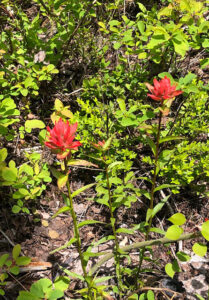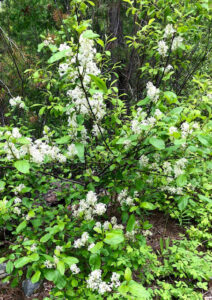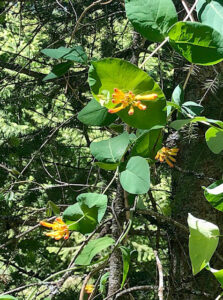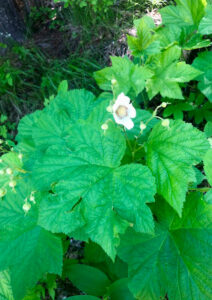
NATIVE PLANTS OF WESTERN MONTANA
By Joyce, Tuharsky, WORC Member
Learning about native plants, and gardening in general, are things you can do right outside in your own backyard. It’s a wonderful way to learn about your local ecology and community. But I have found that my Native Plants hobby is also a joy to take “on the road,” leading to fun discoveries and a better understanding of places I visit.
Recently, my husband and I traveled west to Montana, where I discovered native plants that look so much like our natives in Michigan…. but not quite. The first western native plant I discovered was in the foothills around Boseman, MT. It was silver lupine (Lupinus argenteus) pictured above, which is very similar to blue lupine (Lupinus perennis) in Michigan except its leaflets were much narrower and dusky green (silver?) in color. Also, the flowers are smaller, not so lush looking, perhaps adapted to the dry, rocky soils of the area.
Other native plants in Montana that look familiar to a Michigander, but are different:
- Indian paintbrush: Castilleja miniate in Montana, Castilleja coccinea in Michigan.
- New Jersey tea: Ceanothus herbaceus in Montana, Ceanothus americanus in Michigan.
- Trumpet honeysuckle: Lonicera ciliosa in Montana, Lonicera sempervirens in Michigan.
- Thimbleberry is Rubus parviflorus in both Montana and Michigan!





Probably my favorite plant discovery in Montana was beargrass (Xerophyllum tenax) pictured at left, which we discovered gracing trails in Glacier National Park. It was exciting to see this plant because it only blooms when conditions are right (also affected by elevation and latitude), sometimes only once in every 5–7 years! Ideal conditions include plenty of spring rainfall and moisture present in the soil.
Well, the rivers were gushing!… while we were there, flooding and blocking access to some parts of the park. But we got to see blooming beargrass with its with huge, fluffy flower heads atop thick, fleshy stems that can get up to 6 feet in height. The flower heads consist of a cluster of white, tiny blooms with a sweet tropical-like scent—a striking display that seemed out of place along the rocky trails. This amazing plant got its common name and was referred to often in Lewis and Clarks’ journals. But “beargrass” is a misnomer, because it is in the Liliaceae (lily) family and not a grass. Also, while sheep, deer, elk, and goats are known to eat beargrass; bears do not. It is an evergreen perennial that is found in open woods, primarily in cool, subalpine zones. Native peoples used its long grass-like leaves to weave baskets and other articles.

Another favorite plant discovery for me in Montana was the three-spot mariposa lily (Calochortus apiculatus), also in the Liliaceae family. This plant grows only 4–10 inches high. It has a darling white flower, about 1 ½ inch across, shallow saucer in shape, with 3 broad pointed petals, coarse hairs on the inside and dark, purplish spots on inside base of each petal. So unusual and elegant! It is native to southeast British Columbia and adjacent parts of United States. Later, I learned that there are about 40 species of mariposa lilies native to western North America…. But none here in Michigan!
Photos by Joyce Tuharsky
